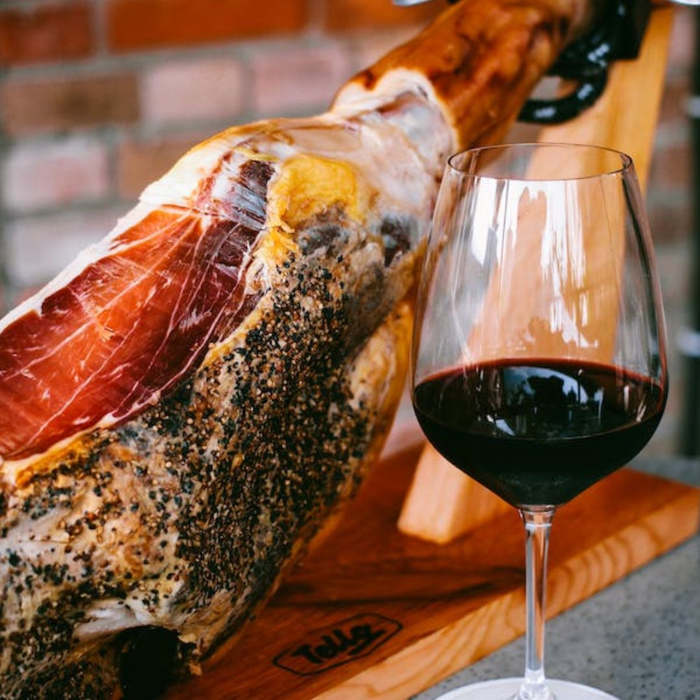
Discovering the Best Spanish Hams: A Guide to Jamón Iberico, Serrano, Jabugo, and Bellota
Serrano ham, also known as Spanish ham, is a staple of Spanish cuisine that has been enjoyed for centuries. The salty and savory flavor of this cured meat has made it a popular choice for tapas, sandwiches, and even as a topping for pizza. But what exactly is Serrano ham and how is it made?
Serrano ham is made from the hind leg of a pig, which is first salted and then air-dried for several months. The traditional method of producing Serrano ham involves hanging the legs in cool, dry rooms for up to two years. During this time, the ham loses moisture and the flavor becomes more intense. The result is a meat that is firm and has a distinctive, salty taste.
One of the key factors in the production of Serrano ham is the pig itself. The pigs are raised on a diet of acorns and other natural foods, which imparts a unique flavor to the meat. This, combined with the long curing process, creates a ham that is unlike any other.
In order to be considered true Serrano ham, the meat must come from specific breeds of pigs, such as the Iberian pig or the Duroc pig, and must be produced in certain regions of Spain. There are also strict regulations in place to ensure the quality and authenticity of the product.
Serrano ham is often served thinly sliced and can be enjoyed on its own, or paired with other ingredients. It is a popular addition to tapas platters, where it is served alongside other cured meats, cheeses, and olives. It can also be used in sandwiches, as a topping for pizza, or as an ingredient in pasta dishes.
In conclusion, Serrano ham is a delicious and versatile food that has been enjoyed by generations of Spaniards. Its unique flavor and texture make it a staple of Spanish cuisine and a must-try for any food lover. Whether enjoyed on its own or as part of a larger meal, Serrano ham is sure to impress.
How iberian ham is made
Iberico ham, also known as pata negra, is a type of cured ham that is highly prized for its rich flavor and texture. This traditional Spanish food is made from the hind legs of Iberico pigs, which are native to Spain and Portugal. The production of Iberico ham is a slow and methodical process, which involves several key steps.
Step 1: Raising the Pigs The Iberico pigs are raised on a diet of acorns and grasses, which imparts a unique flavor to the meat. The pigs are allowed to roam freely and are fed a natural diet, which contributes to the high quality of the ham.
Step 2: Salting and Curing Once the pigs have been slaughtered, the hind legs are salted and left to cure for a period of several months. During this time, the salt penetrates the meat and helps to preserve it. The curing process also helps to develop the characteristic flavor and texture of Iberico ham.
Step 3: Drying and Aging After the curing process, the legs are hung to dry in cool, dry rooms for several months. During this time, the ham loses moisture and the flavor becomes more intense. The aging process can last anywhere from 12 to 36 months, depending on the desired flavor and texture.
Step 4: Slicing and Serving Once the aging process is complete, the Iberico ham is sliced thinly and served. It can be enjoyed on its own, or paired with bread, cheese, and other ingredients. The rich, salty flavor of Iberico ham makes it a popular addition to tapas platters and a staple of Spanish cuisine.
In conclusion, Iberico ham is a traditional Spanish food that is made using a slow and methodical process. The combination of a natural diet, salting, and aging contributes to the rich flavor and texture of this highly prized cured meat. Whether enjoyed on its own or as part of a larger meal, Iberico ham is sure to impress.
Which are the best hams in Spain
Spain is renowned for its cured hams, known as jamón, and there are several types that are considered to be among the best. Some of the most highly regarded jamones from Spain include:
-
Jamón Iberico: This type of ham is made from the hind legs of Iberico pigs and is prized for its rich flavor and tender texture. Iberico ham is made using traditional methods and is aged for several months, which contributes to its unique flavor.
-
Jamón Serrano: Serrano ham is another popular type of Spanish ham that is made from the hind legs of white pigs. It is cured for several months and has a salty, savory flavor that makes it a popular choice for tapas and sandwiches.
-
Jamón de Jabugo: Jabugo ham is made from the hind legs of black Iberian pigs and is known for its intense flavor and delicate texture. This type of ham is aged for at least 18 months and is considered to be one of the best hams in Spain.
-
Jamón de Bellota: Bellota ham is made from the hind legs of acorn-fed Iberico pigs and is considered to be the finest type of ham in Spain. The pigs are raised on a diet of acorns, which imparts a unique flavor to the meat. Bellota ham is aged for at least 36 months and has a delicate, nutty flavor.
In conclusion, these are some of the best hams in Spain, each with its own unique flavor and texture. Whether you prefer the rich, intense flavor of Iberico ham or the delicate, nutty taste of Bellota ham, there is a Spanish ham to suit every taste.
